HPE ProLiant ML110 Gen10 Performance
At STH, we have an extensive set of performance data from every major server CPU release. Running through our standard test suite generated over 1000 data points for each set of CPUs. We are cherry picking a few to give some sense of CPU scaling. We also had a fairly limited selection of Intel Xeon E-2100 series CPUs at launch to test in the server.
Python Linux 4.4.2 Kernel Compile Benchmark
This is one of the most requested benchmarks for STH over the past few years. The task was simple, we have a standard configuration file, the Linux 4.4.2 kernel from kernel.org, and make the standard auto-generated configuration utilizing every thread in the system. We are expressing results in terms of compiles per hour to make the results easier to read.
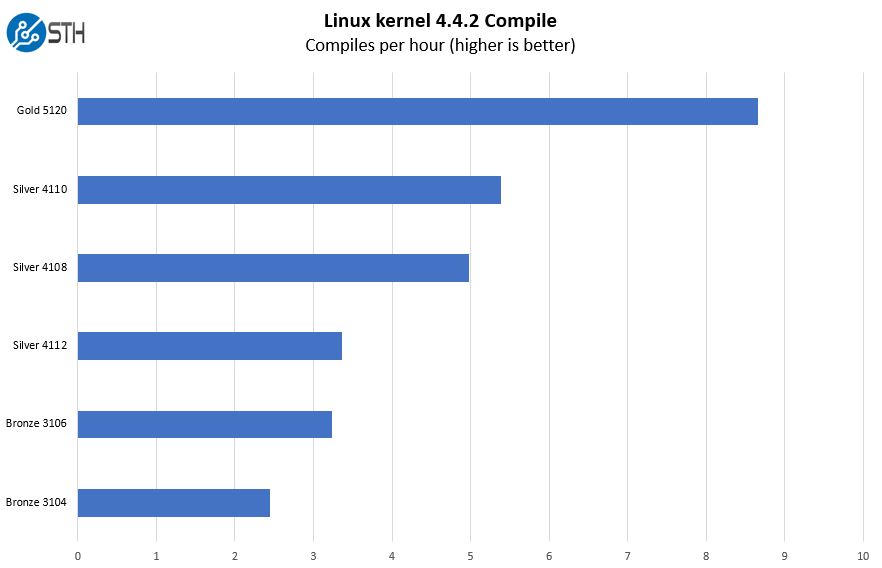
We were able to test all but one of the CPUs (the Intel Xeon Gold 5122) that are listed. We simply did not have an Intel Xeon Gold 5122 in the lab. As you can see, the Intel Xeon Gold 5120 provides the biggest bump in performance over the lower-end SKUs.
c-ray 1.1 Performance
We have been using c-ray for our performance testing for years now. It is a ray tracing benchmark that is extremely popular to show differences in processors under multi-threaded workloads. We are going to use our new Linux-Bench2 8K render to show differences.

One change you may have seen in these results is that the Intel Xeon Bronze 3106 and Intel Xeon Silver 4112 are trading spots. The Intel Xeon Bronze 3106 is an 8 core CPU without Hyper-Threading. The Intel Xeon Silver 4112 is a quad core 8 thread CPU with higher frequencies. Some tests perform well with hyper-threading, some without which is the primary reason, along with clock speeds, that you will see these results so close given their different approaches to performance.
7-zip Compression Performance
7-zip is a widely used compression/ decompression program that works cross-platform. We started using the program during our early days with Windows testing. It is now part of Linux-Bench.
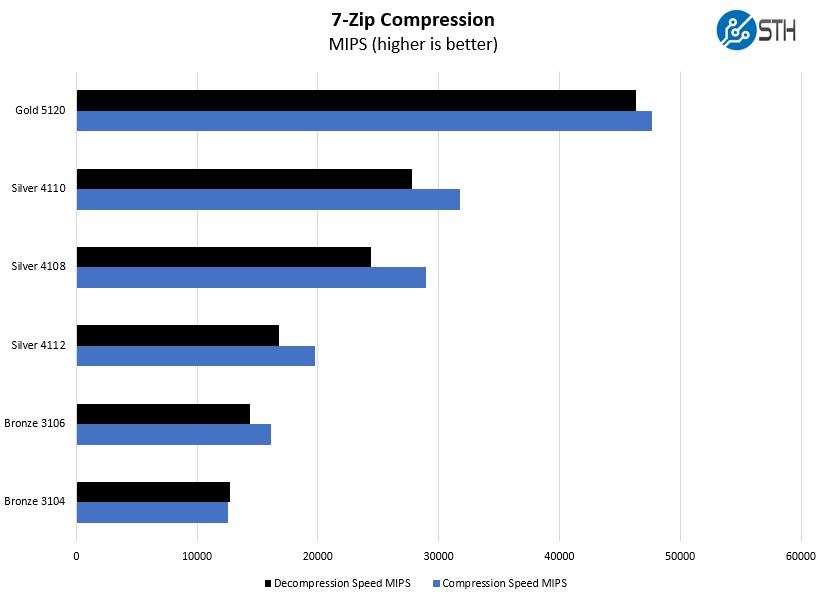
Within the Intel Xeon Silver range, the Intel Xeon Silver 4110 is a clock speed bump over the Intel Xeon Silver 4108. Our test configuration came with the Intel Xeon Silver 4108, however if one gets a good deal, we suggest upgrading to the Silver 4110 for the higher base frequencies.
OpenSSL Performance
OpenSSL is widely used to secure communications between servers. This is an important protocol in many server stacks. We first look at our sign tests:
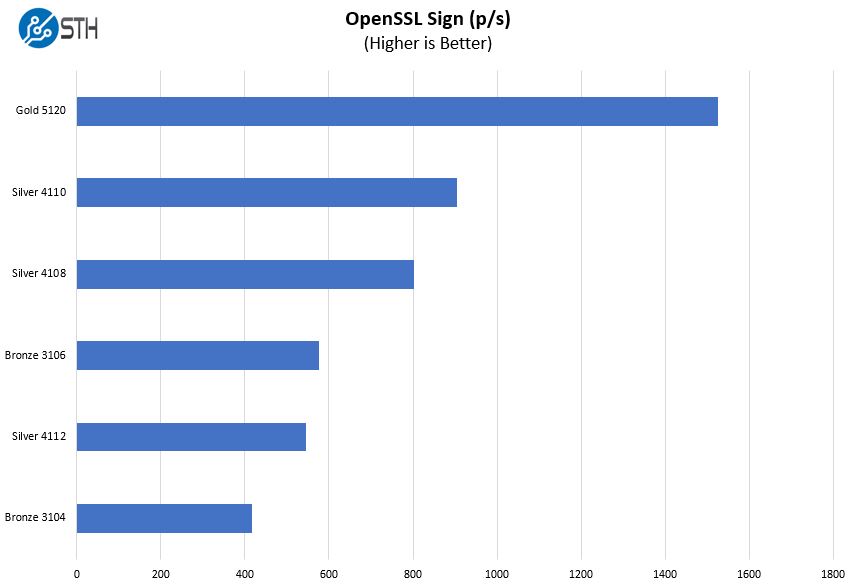
Here are the verify results:
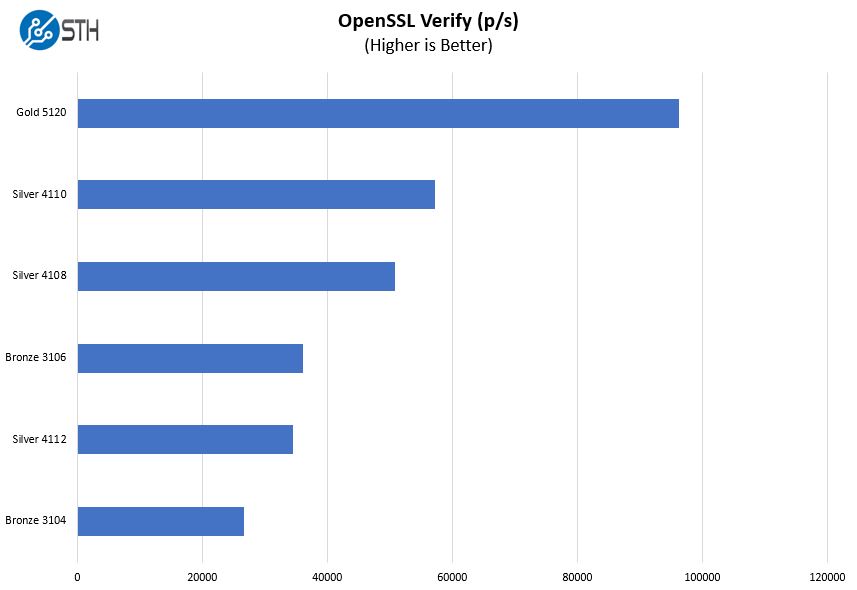
We tend to recommend the Intel Xeon Silver 4112 only in license cost constrained environments where per-core licenses are expensive, but not expensive enough or with enough performance requirements to move up the stack to higher speed CPUs such as the Gold 5122.
We see the Intel Xeon Bronze series as the base “light the platform” parts meant for storage servers and absolutely basic compute duties. The Intel Xeon Silver 4108 provides such an enormous clock and thread advantage that we strongly recommend moving up the stack to the Intel Xeon Silver range over Xeon Bronze if possible. Even for a storage platform, if you ever wanted to re-purpose a HPE ProLiant ML110 Gen10 from a NAS to handling more services or a miniature on-prem hyper-converged node, you want the Xeon Silver SKUs.
Chess Benchmarking
Chess is an interesting use case since it has almost unlimited complexity. Over the years, we have received a number of requests to bring back chess benchmarking. We have been profiling systems and are ready to start sharing results:
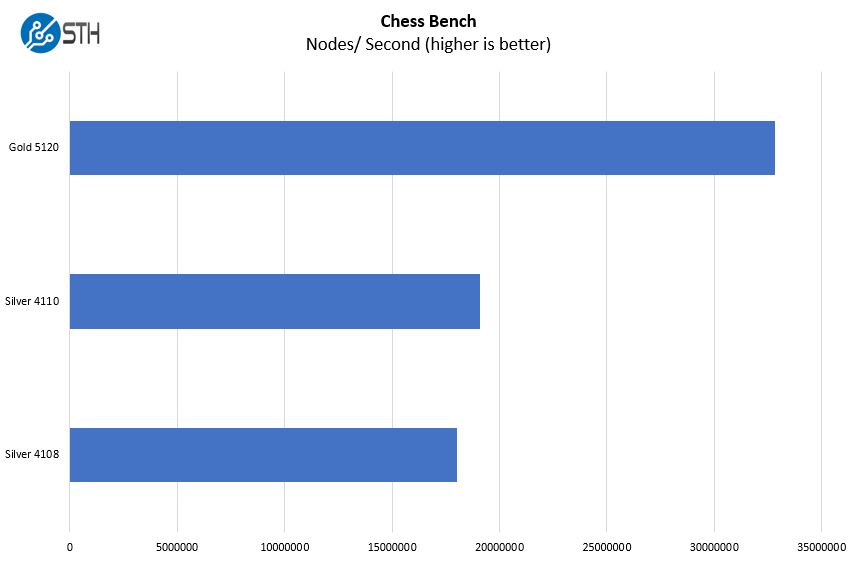
Here we pare down the results to compute-focused parts. One can see that in heavy compute workloads moving to Intel Xeon Gold 5120 with more cores and higher clock speeds is a bigger benefit than just moving from Intel Xeon Silver 4108 to 4110.
GROMACS STH Small AVX2 Enabled
We have a small GROMACS molecule simulation we previewed in the first AMD EPYC 7601 Linux benchmarks piece. In Linux-Bench2 we are using a “small” test for single and dual socket capable machines. Our medium test is more appropriate for higher-end dual and quad socket machines. Our GROMACS test will use the AVX-512 and AVX2 extensions if available. On the Intel Xeon E-2100 series system, this is only AVX2 since the platform does not support AVX-512 like Intel’s higher-end Xeon Scalable parts.
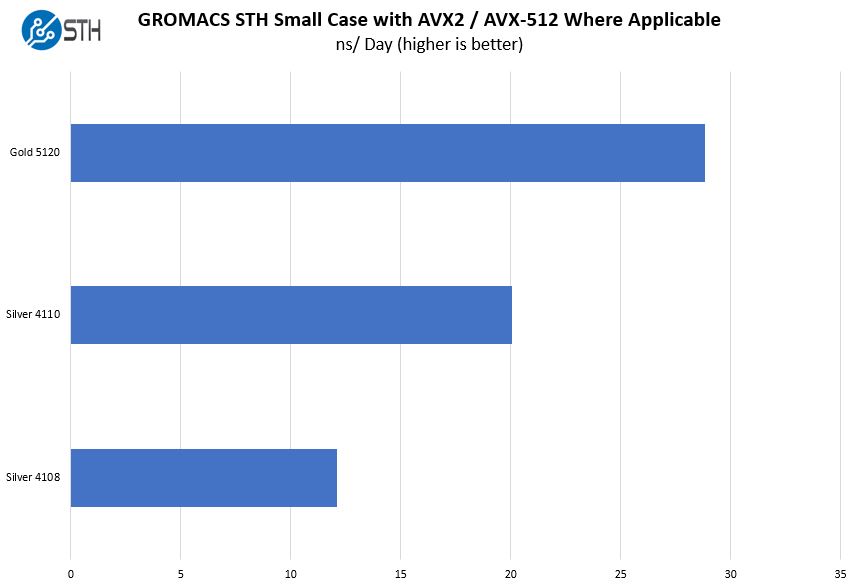
Our AVX-512 test shows more separation between the Silver 4110 and Silver 4108. The Silver 4108 in the HPE ProLiant ML110 Gen10 was not holding higher clock speeds.
Still, if you are concerned with AVX-512 performance, the Intel Xeon Gold 5122 or the Intel Xeon Gold 6100 series are the CPUs you want. They have dual-port FMA AVX-512 which offers so much more performance that if you need AVX-512, you should look in that range.
HPE ProLiant ML110 Gen10 Network and Storage Performance
Generally, in our reviews, we focus on storage and networking performance. Our HPE ProLiant ML110 Gen10 utilizes dual 1GbE networking (HPE Ethernet 1Gb 2-port 332i Adapter) and basic SATA III storage off of an Intel 621 PCH, so we are going to skip that in our review. We will simply note that 1GbE and SATA 6.0gbps speeds were as expected in the platform. This is basic functionality these days, so just about every server will perform similarly.
In the last part of our review, we are going to focus on power consumption and give our final thoughts. on the platform.




don’t want to jump too far ahead and spoil it – haven’t read this yet – but i wonder if it’ll be a 9.3, 9.4, 9.5 or *gasp* a 9.6?!?!?!?!
Honestly I do not understand whole this Bronze/Silver business. Single E-21xx can kill that price/performance/energy-consumption wise. So the only advantage of Bronze/Silver is RDIMM support and up to 768GB RAM. But with today’s prices who would buy this CPU with more than 64GB RAM and 64GB is still supported by E-21xx.
Really thorough review. Good job STH.
KarelG I looked at the specs it only supports 192GB according to HPE since there’s 6 DIMM slots.
Thank god you’re doing real reviews of servers. I hate the garbage pieces by itpro UK where they don’t even seem to review servers nor know why a server is like it is. Do more of these so I can write off itpro as vendor sponsored junk that it is.
I just sent this review to our procurement people for a pre BF buy. Timely.
Or you buy this and upgrade to a Xeon Gold for less than HPE charges… Smart Buy is the bomb tho. We use it all the time.
You didn’t mention this but HPE uses Torx screws everywhere. They suck and they’re difference sizes.
Well doe and thorough review
Thank you for the thorough review Patrick.
I had an unfortunate discovery on a Gen 9 ML350 with iLO4 and I am wondering if the same apparent weakness exists in the Gen 10/iLO5. The iLO on my server suffered a hardware failure. The BIOS then indicated it was preventing the OS from loading. In an attempt to work around it and get our server running, I tried to disable the iLO. Surely, my thinking went, since a BMC should just be for monitoring/management this should be possible, but nope, HPE made the iLO part of the BIOS dependency chain (this was an “upgrade”, in effect as of a certain firmware version, so apparently it’s not how the server was shipped).
Here’s the the note about inability to disable iLO in Gen9: https://support.hpe.com/hpsc/doc/public/display?docId=emr_na-a00018423en_us
Note that HPE support did promptly replace the motherboard in our server to address the issue, so the overall warranty/support experience was positive.
This exposed what seems a very poor design choice to me – essentially turning a positive feature/reliability improvement (BMC) into a potential liability. So I am curious if the Gen 10/iLO5 has the same design.
Also worth noting/remembering that HPE keeps BIOS updates behind a paywall (you have to have an active warranty/support contract). To me this limits resale value/ability to use these in a non-critical workloads (areas where it may otherwise be fine to not have a warranty but where you still want BIOS updates for security, reliability or other reasons). Dell and Supermicro do not do this (in my limited experience). So, depending on your use case, this may effectively reduce the value of any HPE server.
Ya’ll do awesome reviews. We’re fixin to get a few of these.
@Ryan, that does seem like an odd choice since OOB management can be an attack surface that some organizations choose to do without altogether. I know one could just leave the NIC unattached, but some vendors allow the option to expose OOB via the normal ethernet interfaces, so someone with root access could still hijack it…
There is a lot of talk about the iLO Advanced license, but no price is mentioned, or did I miss it?
WRONG for a small business! You can not buy the caddies for drives…you can only buy super expensive drives from HPE!!!!!
Patrick in your review of the MSG10+ you tested compatibility with various server OS including Proxmox. Can you speak to the compatibility of running Proxmox on the ML110 G10? I’ve seen some posts talking about issues installing Proxmox on prior versions of the ML110. Thanks.
Does this power measurements were made with all 8 HDDs installed in server? Because those are taking most of the power.
@Arvis – You can but drive caddies from third party manufactures on ebay – this is where I purchased mine.